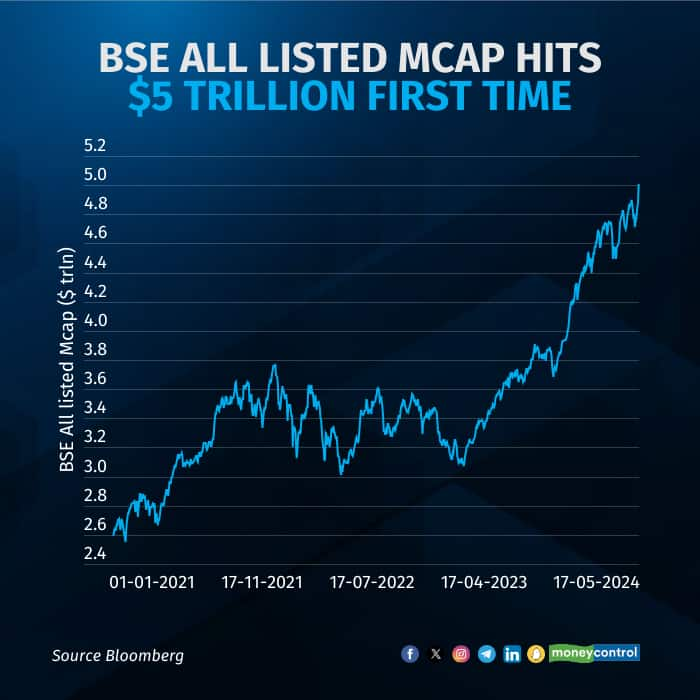The market capitalisation of companies listed on BSE has crossed a record $5 trillion for the first time - hitting a fresh high on May 21 - data on the BSE website showed, underscoring an ongoing rally in the Indian stock markets.
The total market cap of all BSE-listed companies reached $5 trillion or over Rs 414.46 trillion, rising by over $633 billion since the start of the year. Although the flagship Sensex index still remains 1.66 percent below its all-time high, the BSE Mid and Smallcap indices hit fresh high.
The Market Cap Journey
BSE's total market capitalization had hit $4 trillion in November 2023, and has now soared past $5 trillion in just six months. BSE-listed firms reached the market cap of $1 trillion back in May 2007, doubling in over a decade to $2 trillion in July 2017, and then reaching the $3 trillion mark in May 2021.

| WORLD MARKET | MARKET CAPITALIZATION (DOLLAR TRILLION) |
| USA | 55.65 |
| China | 9.4 |
| Japan | 6.42 |
| Hong Kong | 5.47 |
What's Fuelling The Rally
The surge in the market capitalization of Indian equities was primarily driven by a surge in broader market indices. While benchmark Sensex has risen by just 2.3 percent so far in 2024, BSE Midcap and Smallcap are up by 16.3 percent and 11.5 percent, respectively. These gains has come despite volatility in equities in recent months.
Volatile Times
According to Deepak Jasani, an analyst with HDFC Securities, despite volatility in benchmark indices like Sensex and Nifty, midcap and smallcap indices have shown gains. This volatility has increased ahead of the upcoming Indian election results, expected later this month. Analysts predict that the turnout for this year's election has been comparatively low, possibly affecting the outcome, with the BJP failing to reach its desired number of 350-400 seats.
However, the surge in midcap and smallcap stocks is attributed to factors such as lower Foreign Portfolio Investor (FPI) holdings, limited fear of sell-offs directly due to adverse outcomes, and the influence of company developments and results on these stocks, Jasani added.
Analysts believe that while these segments may not remain insulated from broader market trends indefinitely, corrections may be limited due to controlled float and investor behavior. Analysts are anticipating a potential negative trigger, with the expected election outcome serving as a catalyst for significant profit-taking and sell-offs in the market. For midcap and smallcap stocks in the current quarter, margins are under pressure across the board, although topline performance remains relatively stable, analysts added.
Axis Securities analysts suggest that despite possible near-term consolidation, investors should view market corrections as opportunities to increase equity exposure. It's advised to focus on the long term and ignore short-term fluctuations. India's valuations remain high compared to its Asian peers. Strong macroeconomic indicators, including low inflation, anticipated interest rate cuts, increased industrial activity, and improvements in twin deficits, have fostered optimism and a favorable economic environment. Markets have factored in expectations for continuity in government policies. India's long-term growth outlook remains promising, with a projected GDP growth of 7% for FY25, allowing the RBI flexibility to maintain rates at 6.5%. Falling headline inflation and a favorable monsoon forecast are expected to alleviate price pressures. High-frequency indicators such as PMIs, GST collections, and domestic passenger growth are positive compared to historical standards, Axis Securities said.
Disclaimer: The views and investment tips expressed by investment experts on Moneycontrol.com are their own and not those of the website or its management. Moneycontrol.com advises users to check with certified experts before taking any investment decisions.

No comments:
Post a Comment